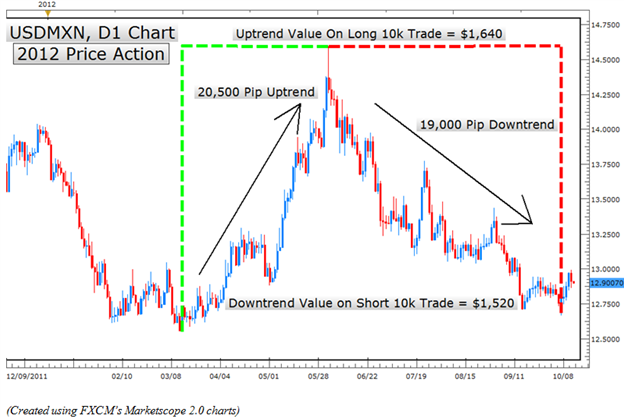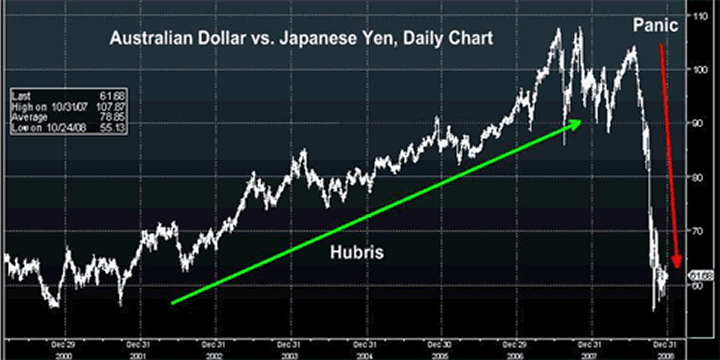Currency Carry Trade
Post on: 13 Апрель, 2015 No Comment

Definition of Currency Carry Trade
A strategy in which an investor sells a certain currency with a relatively low interest rate and uses the funds to purchase a different currency yielding a higher interest rate. A trader using this strategy attempts to capture the difference between the rates, which can often be substantial, depending on the amount of leverage used
Example:
For this example well take a look at Joe the Newbie Forex Trader.
Its Joes birthday and his grandparents, being the sweet and generous people they are, give him $10,000.
Instead of going out and blowing his birthday present on video games and posters of bubble gum pop stars, he decides to save it for a rainy day. Joe goes to the local bank to open up a savings account and the bank manager tells him, Joe, your savings account will pay 1% a year on your account balance. Isnt that fantastic?
Joe pauses and thinks to himself, At 1%, my $10,000 will earn me $100 in a year. Joe, being the smart guy he knows of a better way to invest his money.
So, Joe kindly responds to the bank manager, Thank you sir, but I think Ill invest my money somewhere else. Joe has been demo trading several systems (including the carry trade) for over a year, so he has a pretty good understanding of how forex trading works. He opens up a real account, deposits his $10,000 birthday gift, and puts his plan into action.
Joe finds a currency pair whose interest rate differential is +5% a year and he purchases $100,000 worth of that pair. Since his broker only requires a 1% deposit of the position, they hold $1,000 in margin (100:1 leverage). So, Joe now controls $100,000 worth of a currency pair that is receiving 5% a year in interest.
Well, here are 3 possibilities. Lets take a look at each one:
- Currency position loses value. The currency pair Joe buys drops like a rock in value. If the loss brings the account down to the amount set aside for margin, then the position is closed and all thats left in the account is the margin
- The pair ends up at the same exchange rate at the end of the year. In this case, Joe did not gain or lose any value on his position, but he collected 5% interest on the $100,000 position. That means on interest alone, Joe made $5,000 off of his $10,000 account. Thats a 50% gain! Sweet!
- Currency position gains value. Joes pair shoots up like a rocket! So, not only does Joe collect at least $5000 in interest on his position, but he also takes home any gains! That would be a nice present to himself for his next birthday!
Because of 100:1 leverage, Joe has the potential to earn around 50% a year from his initial $10,000.
Here is an example of a currency pair that offers a 4.40% differential rate based on interest rates as of September 2010:
If you buy AUD/JPY and held it for a year, you earn a positive carry of 4.40%.
Of course, if you sell AUD/JPY, it works the opposite way:
If you sold AUD/JPY and held it for a year, you would earn a negative carry of 4.40%.
Carry trades work best when investors feel risky and optimistic enough to buy high-yielding currencies and sell lower yielding currencies.
Its kinda like an optimist who sees the glass half full. While the current situation might not be ideal, he is hopeful that things will get better. The same goes for carry trade. Economic conditions may not be good, but the outlook of the buying currency does need to be positive.
If the outlook of a countrys economy looks as good, then chances are that that countrys central bank will have to raise interest rates in order to control inflation.
This is good for carry trade because a higher interest rate means a bigger interest rate differential.

On the other hand, if a countrys economic prospects arent looking too good, then nobody will be prepared to take on the currency if they think the central bank will have to lower interest rates to help their economy.
To put it simply, carry trades work best when investors have low risk aversion .
Carry trades do not work well when risk aversion is high (i.e. selling higher-yielding currencies and buying back lower-yielding currencies). When risk aversion is high, investors are less likely to take risky ventures.
Lets put this into perspective.
Lets say economic conditions are tough, and the country is currently undergoing a recession. What do you think your next door neighbor would do with his money?
Your neighbor would probably choose a low-paying yet safe investment than put it somewhere else. It doesnt matter if the return is low as long as the investment is a sure thing.
This makes sense because this allows your neighbor to have a fall back plan in the event that things go bad, e.g. he loses his job. In forex jargon, your neighbor is said to have a high level of risk aversion .
The psychology of big investors isnt that much different from your next door neighbor. When economic conditions are uncertain, investors tend to put their investments in safe haven currencies that offer low interest rates like the U.S. dollar and the Japanese yen.
Carry Trade Criteria
Its pretty simple to find a suitable pair to do a carry trade. Look for two things:
- Find a high interest differential.
- Find a pair that has been stable or in an uptrend in favor of the higher-yielding currency. This gives you the ability to stay in the trade AS LONG AS POSSIBLE and profit off the interest rate differential.
Up until recently, the Bank of Japan has maintained a Zero Interest Rate Policy (as of September 2010, the interest rate stands at 0.10%).
With the Reserve Bank of Australia touting one of the higher interest rates among the major currencies (currently at 4.50% as of this writing), many traders have flocked to this pair (one of the factors creating a nice little uptrend in the pair).
From the start of 2009 to early 2010, this pair moved from a price of 55.50 to 88.00 thats 3,250 pips!
If you couple that with interest payments from the interest rate differential of the two currencies, this pair has been a nice long term play for many investors and traders able to weather the volatile up and down movements of the currency market.
Of course, economic and political factors are changing the world daily. Interest rates and interest rate differentials between currencies may change as well, bringing popular carry trades (such as the yen carry trade) out of favor with investors.
(No Ratings Yet)
Loading.














